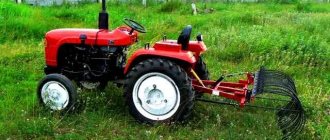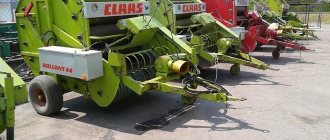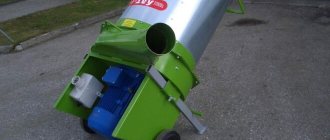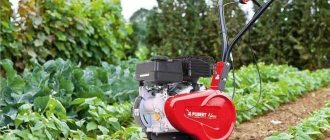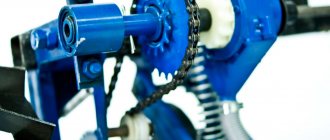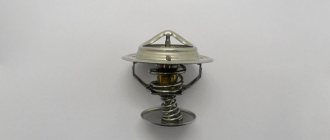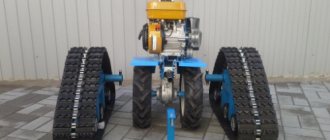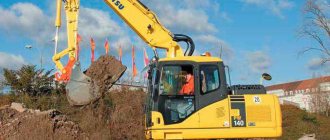Baler for walk-behind tractor
A baler for a walk-behind tractor allows farmers to better remove dry plant matter remaining after harvesting grain crops. This device compresses dried straw into compact rectangular or cylindrical briquettes (depending on the type of device), which can then be easily transported and stored. There are hay pickers not only for full-fledged agricultural machinery, but also for low-power mini-tractors and walk-behind tractors.
It should be immediately noted that currently all models of hay pickers for walk-behind tractors, which are produced by Russian and foreign manufacturers, are designed for use with heavy-duty power units with a power of at least 10 hp. This is due to the fact that even light devices weigh about 350 kg, plus the mass of hay, even middle-class units can hardly cope with this, so what can we say about light walk-behind tractors. However, there are homemade balers that are also adapted to light power plants.
How to choose a baler?
The agricultural machinery market is filled with forage harvesting units from various manufacturers, with equally diverse technical potential and modifications.
How not to get confused, what to pay special attention to?
When choosing a special vehicle, you should not rely solely on the successful marketing of interested companies or proceed only from the purchase price.
A low price can hide an equally low quality of assembly, materials, and therefore productivity and wear resistance.
Main criteria
Based on the comparative characteristics and recommendations set out in the article, compare them with the following indicators:
1. Compliance with the conditions, potential, and objectives of your specific farm
Namely:
- For what livestock, in what volumes, what kind of feed needs to be prepared.
- What types of plant crops are planned for processing.
- What areas need to be harvested from?
- What are the deadlines for procurement work?
2. Specifications
Pay attention to:
- special vehicle power;
- quality of design, materials, wear resistance;
- productivity level;
- density of formed ligaments;
- model, dimensions of the pressing chamber;
- speed;
- working width;
- cost-effectiveness, ease of use and maintenance.
3. Manufacturer
It is preferable to choose a special vehicle from a well-known manufacturer with a proven track record of quality equipment.
In particular, John Deere is a leader in the production of reliable, wear-resistant agricultural equipment.
Regardless of the size of the agricultural enterprise, volume and type of work, this manufacturer will have the necessary equipment.
John Deere produces cars with cameras of constant and variable volume.
Claas has proven itself to be one of the most conscientious, reliable manufacturers and importers of feed harvesting units on the world market, in farms in Russia and the CIS.
The following are in great demand:
- roll special machines of the Claas ROLLANT, Claas VARIANT series,
- bale – MARKANT, QUADRANT.
Sipma is a popular company among Polish manufacturers, whose product range contains a sufficient selection of high-quality and relatively inexpensive agricultural machinery.
Do you want to know which baler is better: Claas, Sipma or John Deere?
Remember the main advice: the one that will be most profitable on YOUR farm.
Don’t forget that by purchasing a forage harvesting unit with basic equipment, you can modify it, make it more comfortable, and adapt it best to the requirements of the agricultural enterprise by purchasing additional equipment.
4. Price
Not every farmer can afford to buy an expensive special machine, and, in other cases, there is no need to overpay for the brand.
Economy option
Relatively inexpensive machines for small volumes of procurement work, forming +-25 packages/hour, with simple equipment, produced in Russia, Belarus, Poland, Italy.
Belarusian rolls are popular on the market today. They are somewhat inferior in compaction density to Western models, but are quite suitable as an economy class option.
In terms of bale units, there is a significant demand for Polish and Italian models, which are cheaper than analogues of world brands.
All of them can be equipped with devices for tying with mesh or film.
- A livestock farming enterprise that produces hay/straw may well opt for a low-cost bale or roll machine.
- However, when planning to use a pick-up for making silage, you should not save money. Buy a high-strength unit equipped with a shredder and the ability to wrap with mesh.
Moderately expensive
Middle-class Western-made machines will perfectly cope with the tasks of farming. They are a little more expensive, but the prices are quite reasonable.
If you have the funds, when purchasing a unit, proceed from the degree of its versatility. Choose one with a variable volume chamber and a chopper.
Attention!
Do you want to take advantage of the opportunity to have high-quality equipment at your disposal while saving money?
We can offer you used square balers from a European manufacturer, which have not been used in the CIS, have been thoroughly tested, and are fully prepared for use.
Popular baler models
The PPR-50 hay harvester can be installed with Neva walk-behind tractors; it has an affordable price and good functionality. This unit is compatible with walk-behind tractors with a power of 10 horsepower or more. Among the disadvantages, the absence of a protective casing is noted, which contributes to the loss of part of the dry plant mass through the rollers.
Open pressing chamber "Kazachok" Berdyansk PPR-50
| Options | Index |
| Processing width, mm. | 800 |
| Speed, km/h. | until 6 |
| Minimum power, l/s. | 10-12 |
| Maximum weight of pressed briquettes, kg. | 20 |
| Dimensions (l/w/h), mm. | 2 500/1 600/1 500 |
| Equipment weight, kg. | 350 |
Mini R-500. This Italian-made baler is almost 1.5 times superior to its Russian counterpart in terms of functionality and weight. The unit is characterized by high maneuverability and the ability to work in any area. The hay picker has small dimensions, high productivity and modern equipment.
WOLAGRI R500 Baling chamber Network tying device
| Options | Index |
| Processing width, mm. | 1 300 |
| Dimensions of packed hay, mm. | 570/630 |
| Power, l/s. | from 11 |
| Maximum bale weight, kg. | 55 |
| Unit dimensions (l/w/h), mm. | 1 800/1 400/1 200 |
| Weight of equipment, kg. | 520 |
RXYK 0850. Today it is a roll type, which is highly powerful and can be used for working with roughage. The model is characterized by its small size and forms compact cylindrical briquettes, which greatly facilitates their loading and transportation by one person.
| Options | Index |
| Processing width, mm. | 800 |
| Packed briquette dimensions, mm. | up to 700 |
| Minimum power, l/s. | from 24 |
| Operating speed, km/h. | 5 |
| Dimensions (l/w/h), mm. | 1 150/1 300/1 200 |
| Equipment weight, kg. | 390 |
Main functions, types, classification of fodder machines
General purpose – selection of plant raw materials intended for harvesting, pressing, molding into briquettes.
Wherein:
- the labor intensity of the process is significantly reduced;
- the drying period of natural material is reduced;
- saves time on cleaning;
- workers are freed up, so necessary in agricultural production.
Products produced during the short off-season period will be excellent food for animals throughout the year.
Having common functions, machines are divided into categories:
- According to the shape of the briquette formed:
- bale;
- roll
- By pressing density, (kg/m3):
- low – up to 100;
- average – 100-200;
- High – from 200.
- By type of bale chamber:
- fixed;
- variable;
- universal.
- According to the pressing mechanism:
- roller;
- belt;
- chain;
- slatted
- According to the method of loading vegetation:
- frontal;
- above;
- on the side.
- By aggregation type.
- In terms of power, strength, wear resistance.
- By cost.
Now let’s make a more detailed comparison of balers, focusing on each type of special machines, features, advantages, and disadvantages.
Roll and bale special machines
The name, as well as the main difference between the machines, is determined based on the configuration of the fodder crop briquettes they form:
- rolls – cylindrical;
- bales are rectangular.
What you should know about the roll unit
Advantages
- Fast roll-up cycle.
- Easy to operate and maintain compared to bale machines.
- Possibility of replacing spare parts yourself.
Flaws
The significant size of the formed rolls entails the need for additional resources and costs in the form of:
- lifting special vehicles;
- fuel;
- work force.
Types of bale chambers
By what criteria do they differ?
- According to the section design:
- fixed (constant) – with an unchangeable section
- changeable (variable) – with variable cross-section
- combined (universal)
- According to the pressing mechanism:
- roller
- chain-slat
- belt
Let's take a closer look.
1) Fixed cameras
- have a constant cross-section;
- roll rolls of the same size;
- easy to maintain;
- easy to repair;
- cheaper than changing designs.
a. Chain-slat:
- One of the most common variations.
- The main advantages are low cost and ease of maintenance.
- Recommended for use on dry plant material (straw, hay).
Important!
We do not recommend use for harvesting work with forage crops such as alfalfa and legumes. Rough processing injures, breaks off the delicate foliage, leaving only stems, reducing the nutritional value of the workpiece.
Not suitable for wet raw materials (silage, haylage):
There is not enough bar pressure power for tight crimping, as a result of which
- the bar will bend, the chains will stretch, and the mechanism will fail;
- the quality of future feed will decrease.
How could this be related?
This is interesting:
At a low compaction density, air enters the workpiece, which inhibits the development of lactic acid bacteria necessary for silage and, on the contrary, promotes the production of harmful aerobic microorganisms.
b. Roller:
- Provides significant compaction density.
- Recommended for harvesting wet plant materials and haylage.
- It is not suitable for processing dry material, since light-weight substances do not curl, but “fall off,” which negatively affects the density and shape of the briquette.
Thus, the roller chamber is suitable for increased loads and is suitable for preparing silage or haylage with a humidity of over 40, up to 60%.
Manufacturers of such units are Claas, Kverneland, Kuhn.
c. Belt:
- Has a significant roll overlap area.
- Ensures minimization of raw material losses, gentle processing, and preservation of foliage of delicate crops.
- Forms high-density ligaments.
We recommend it to agricultural farms cultivating legumes and preparing haylage.
Important!
In arid areas, it requires regular cleaning (blowing) and removal of straw dust to prevent fire.
d. Combined (universal):
- It combines a chain-slat device (which picks up and rolls vegetation into a roll) and rollers or belts with rolling pins (which compress raw materials).
Recommended for processing dry and wet material.
This type of design is, for example, manufactured by John Deere and Kverneland.
For reference:
Why do special machines with a chamber of fixed cross-section produce rolls with a diameter of 1.2 m? It is at this volume that the raw materials are compressed with high quality, and as a result, good feed is obtained.
Which baler is better, roller or chain baler?
roller design, which produces high-quality pressing, is suitable for processing fresh, green vegetation, but is not recommended for dry materials that have the potential to slip and stall.
For haylage and straw, it is advisable to purchase a combined chamber where rollers and chains .
Roller - will provide a higher degree of compression compared to chain .
The compaction density will allow:
- form a smaller number of rolls from raw materials;
- save on transport, labor, strapping material, time.
2) Variable cameras:
- They have a variable cross-section.
- Rolls of various diameters are produced.
- More expensive than cars with constant variation by 30%.
a. Belt camera:
- The best pressing of raw materials.
- Forms the most dense rolls, right from the very core. When filled, it gradually expands, continuing pressing.
- Ideal for making haylage with a moisture content of up to 40%. At higher rates, the belts will be subjected to significant stress.
- It is possible to vary the diameter of the rolls for various types of feed, which can also be useful for a variety of storage and transportation conditions.
- Some models provide the ability to regulate pressure from 50 bar (to obtain a loose “breathing” center) with a subsequent increase to 200-300 bar (thereby ensuring the density and moisture resistance of the outer layer).
- The disadvantage is the high cost.
Important!
For arid areas: in order to avoid fire when processing straw, it requires constant blowing and removal of straw dust.
b. Semi-variable camera:
- The basis of the mechanism is a constant plank design with expansion potential.
- The raw material is pressed in a chamber with a diameter of 1.2 m, then expanded to the required size.
- High density pressing.
- Recommended for farms for which the predominant raw material is straw.
Important!
Does not require constant purging of belts.
c. Universal (combined) variable camera:
- Recommended for dry and wet raw materials. The crimping is done with rollers, and the roll is picked up and wrapped using a bar.
- Doesn't press from the middle. The quality of the briquette practically does not differ from that produced by equipment with a constant cross-section.
It will be educational to watch video material of a baler operating in the field, get a visual impression, and get an idea of specific models. We think you will appreciate the functionality, versatility, and usefulness of special vehicles.
Which round baler is the best to buy?
When choosing a special vehicle, read the opinions of specialists from manufacturing companies:
John Deere experts recommend proceeding from the size of the cultivated area and the volume of forage crops.
If the volume of preparations is up to 1 thousand packages during the harvesting season - a unit with basic equipment, up to 5 thousand pieces, is enough - you will need middle-class special machines that roll rolls up to one and a half meters in diameter.
In this case, the chamber can be of either constant or variable cross-section.
CLAAS specialists note:
Medium specification forage harvesting machines are equipped with more powerful, reinforced rollers, durable chains, and belts with a larger cross-section.
Claas pick-ups are offered with a wide selection of additional equipment that optimizes the operator’s work and saves time on maintenance.
— Specialists from outstanding manufacturing companies believe that the most optimal roll size is 1.20×1.25 m:
They are more convenient for transportation. Two such blanks are two and a half meters wide, which fits well within the dimensions permitted for public roads, which means that no accompanying vehicle is required.
We recommend:
When purchasing a unit, pay attention to what kind of feeder (mechanism that feeds plants) it is equipped with:
- for low and medium productivity, forming up to 1 thousand packages per season, a finger feeder is sufficient;
- For high-performance processing of high-humidity raw materials, it is more effective to use a feeder with a rotary chopper.
Attention!
If you specialize in silage, when deciding which round baler is best to buy for your farm needs, remember: you need a durable, productive unit, equipped with durable components and a chopping mechanism.
Such, for example, as the claas rollant 44, claas rollant 46, 66, claas rollant 250 balers, which:
- equipped with spirally arranged rollers made of sheet steel;
- are available in the basic version and the ROTO-KAT version (with rotary knives);
- simple, reliable, knit with twine, net;
- convenient for working in small areas as well as when pressing large volumes of feed.
What you need to know about bale units
Advantages
- Variability:
- ability to adjust density;
- form small bales;
- carry out loading for transportation both manually and using mechanical manipulators.
- Higher performance indicators compared to rolls:
- compaction density level;
- productivity (do not require stopping during packaging).
- Gentle processing, reducing losses when pressing delicate legumes.
- The ergonomics of the rectangle contributes to:
- Rational use of storage space (for example, placing bundles in several rows);
- placement in the vehicle body is 1.2 times more bales than rolls;
- for use as temporary fencing for animals.
- A powerful bale machine will replace 7 PRF units.
Flaws
The high price of the special vehicle, which is fully compensated by its advantages.
This is interesting:
There is a technology for pressing several small bales from 30cm to 1m 35cm into one large one, up to 3m 20cm in size, which reduces transport costs; the possibility of dividing the briquette into small bales again will facilitate the work of distributing feed on the farm.
Which square baler to choose
For small agricultural farms with a small number of livestock, small and medium-sized bales are suitable, packing small-sized bundles weighing 25-30 kg, which are easy to carry by hand.
One of these is Sipma Z-224-1. A proven, reliable, uncomplicated bale made in Poland (lately also assembled in Belarus). Highly productive, easily aggregated with most tractors from T-40 to MTZ-80 and modern Belarus models. Spare parts are readily available.
Advice:
It will be possible to unload finished bundles from a small bale directly into a trailer by equipping it with a special unloading device.
For large farms that produce more than 10 thousand packages of straw per season/more than 40 pcs/hour, a powerful, high-performance bale is needed. As such, we can recommend John Deere 224, John Deere 342, John Deere 359.
We recommend:
When buying a high-power machine, you should remember that the farm must have at its disposal manipulators (loaders) capable of loading bulky and heavy workpieces onto vehicles with subsequent unloading.
When choosing a bale, remember that high-density packaging requires careful adherence to the recommended moisture content of the raw materials and removal of briquettes from the field before precipitation appears.
Agricultural enterprises whose climatic conditions do not allow keeping raw material humidity below 16% will require the use of preservatives when preparing feed.
Making a hay picker in a home workshop
A homemade hay harvester can be no worse than one bought at an agricultural equipment store. Moreover, when making a mini-pickup yourself, you can rely on the parameters of the available power unit (for example, a motor cultivator).
The baler is assembled according to the simplest scheme:
- Creation of a chassis on two pneumatic wheels.
- Installation of the conveyor and front cover on the chassis.
- It is advisable to purchase the pressing device assembled (for example, on the Internet in a special section in the “buy and sell” section). The finished block consists of a grid, several rollers and springs.
- Connect the two-speed gearbox to the driveshaft of the walk-behind tractor.
- For greater efficiency, it is recommended to install large gears on the receiving platform.
A factory-made baler or one made independently will save effort, time and money. And also get a good income from your activities and reduce feed losses.
How do you like the article?
